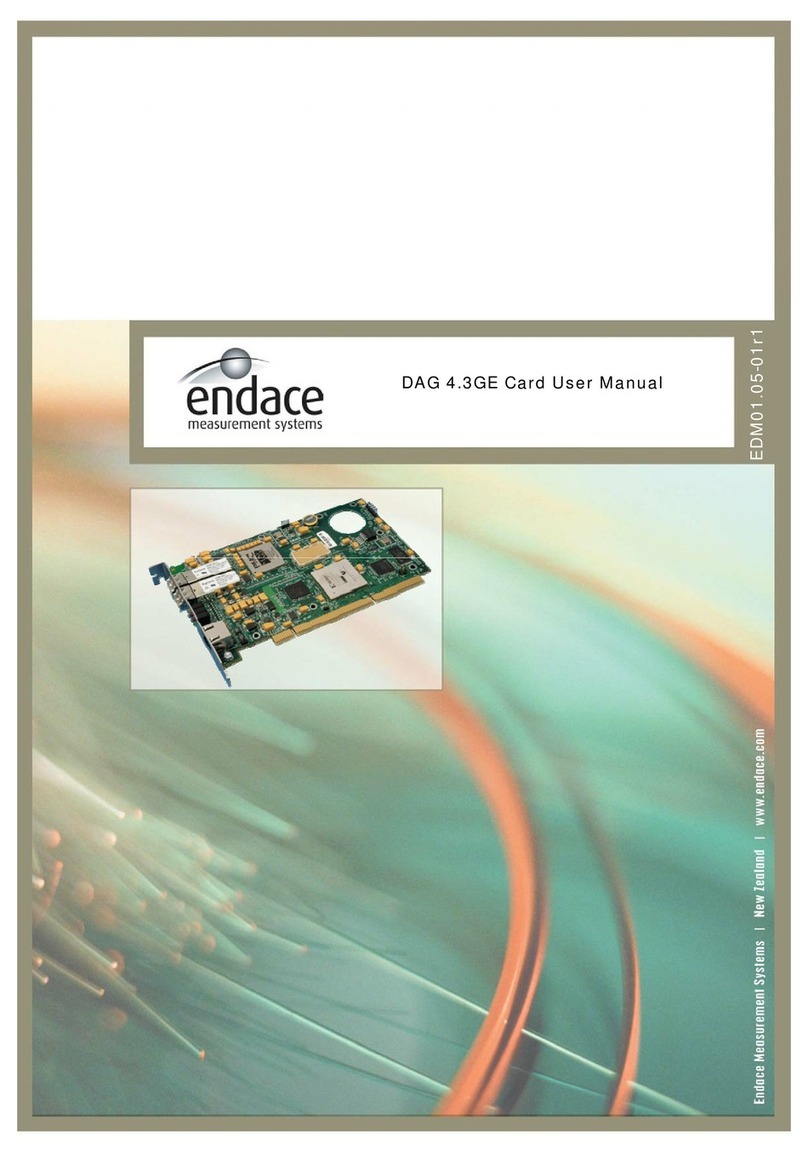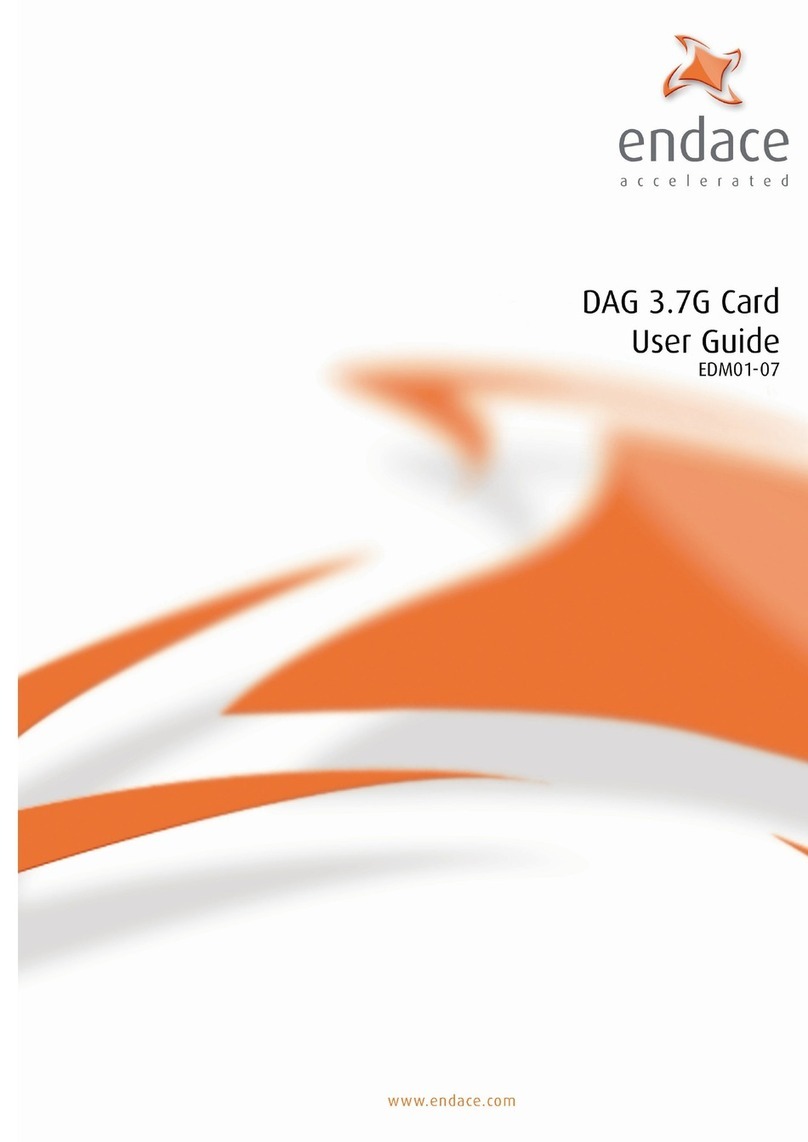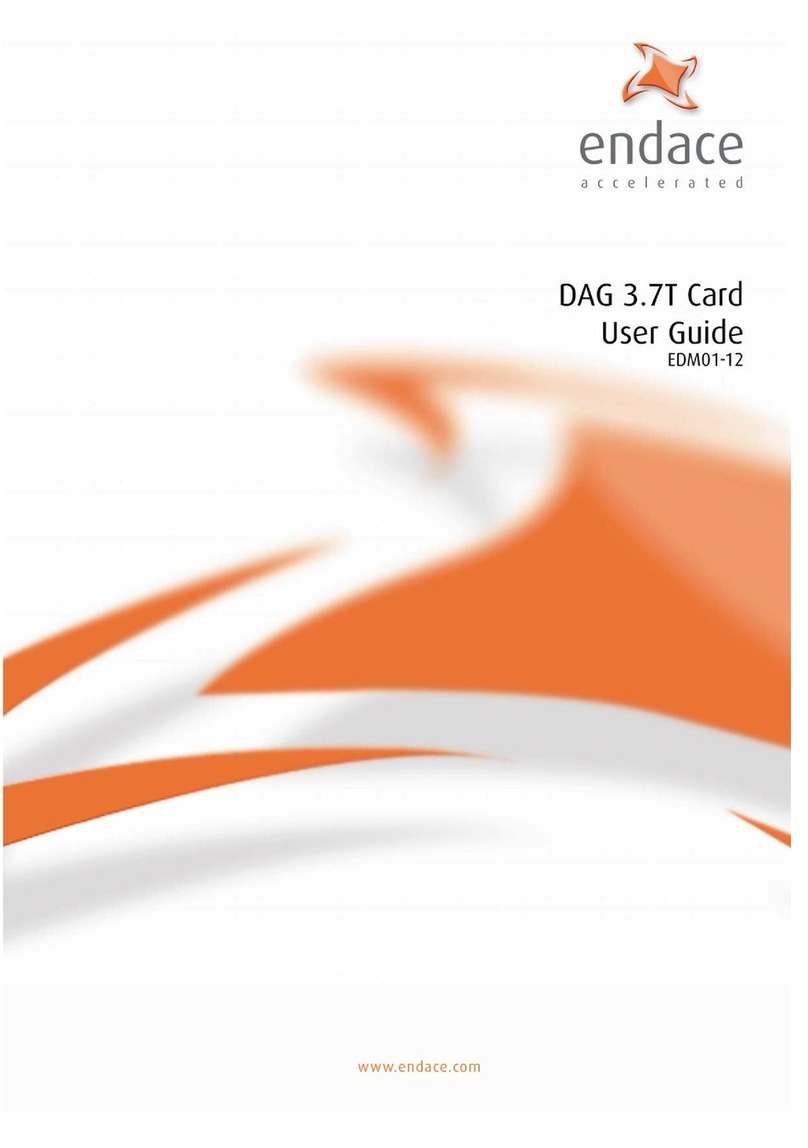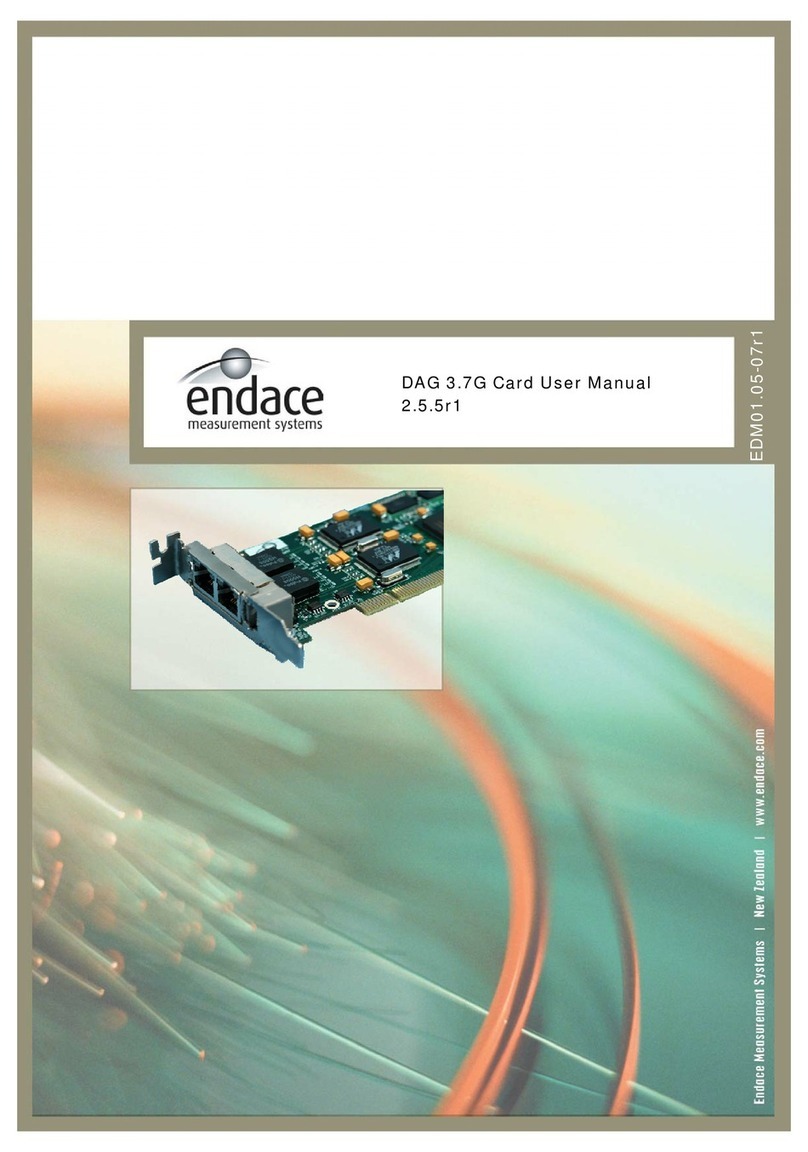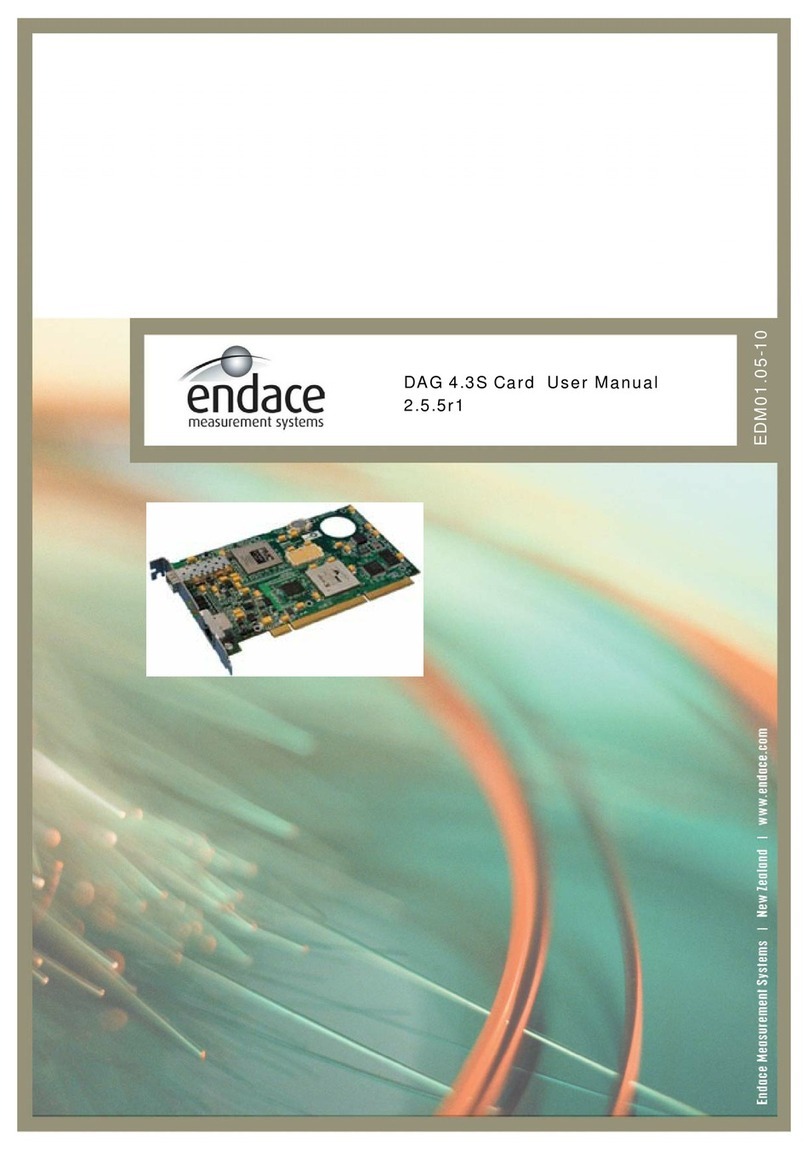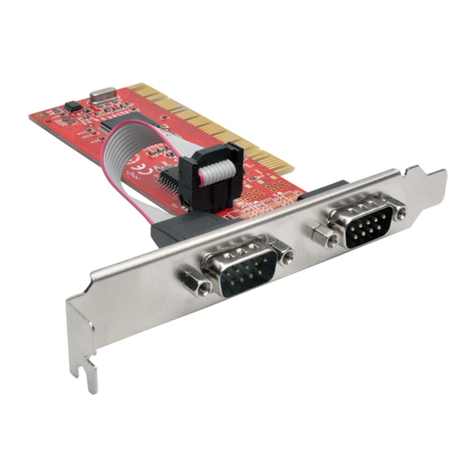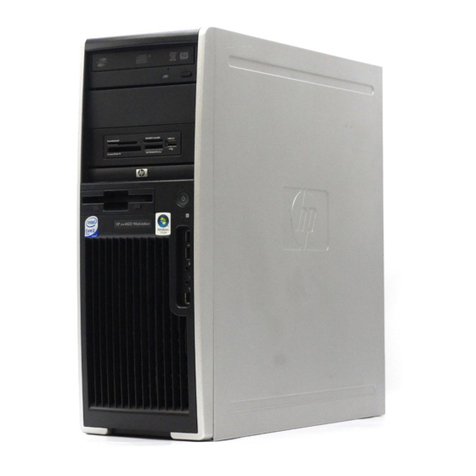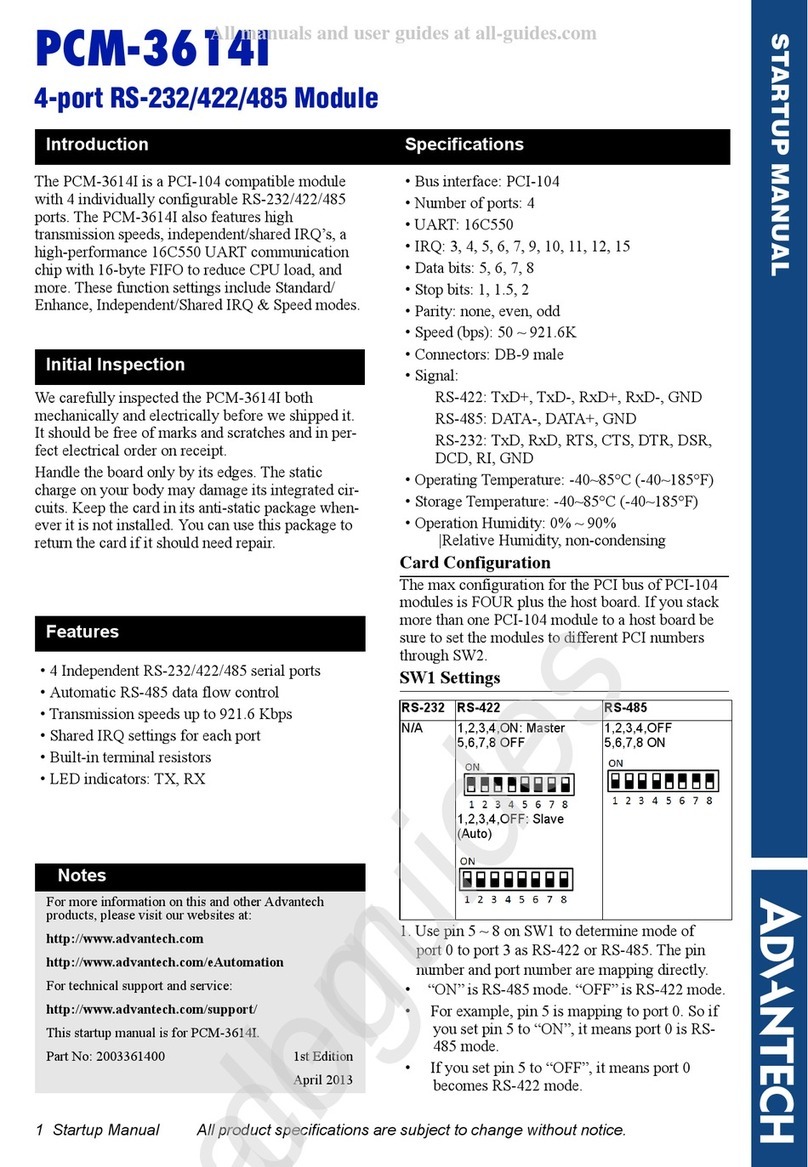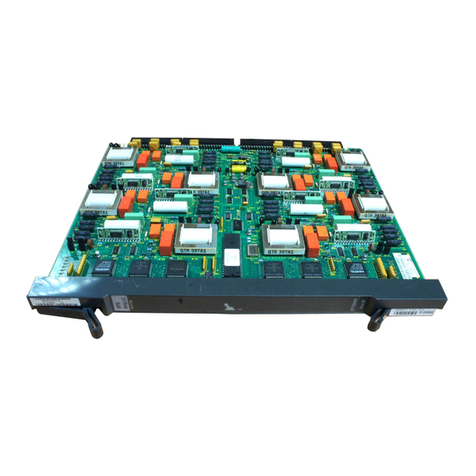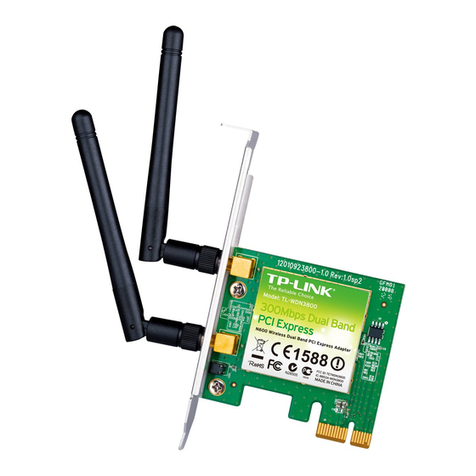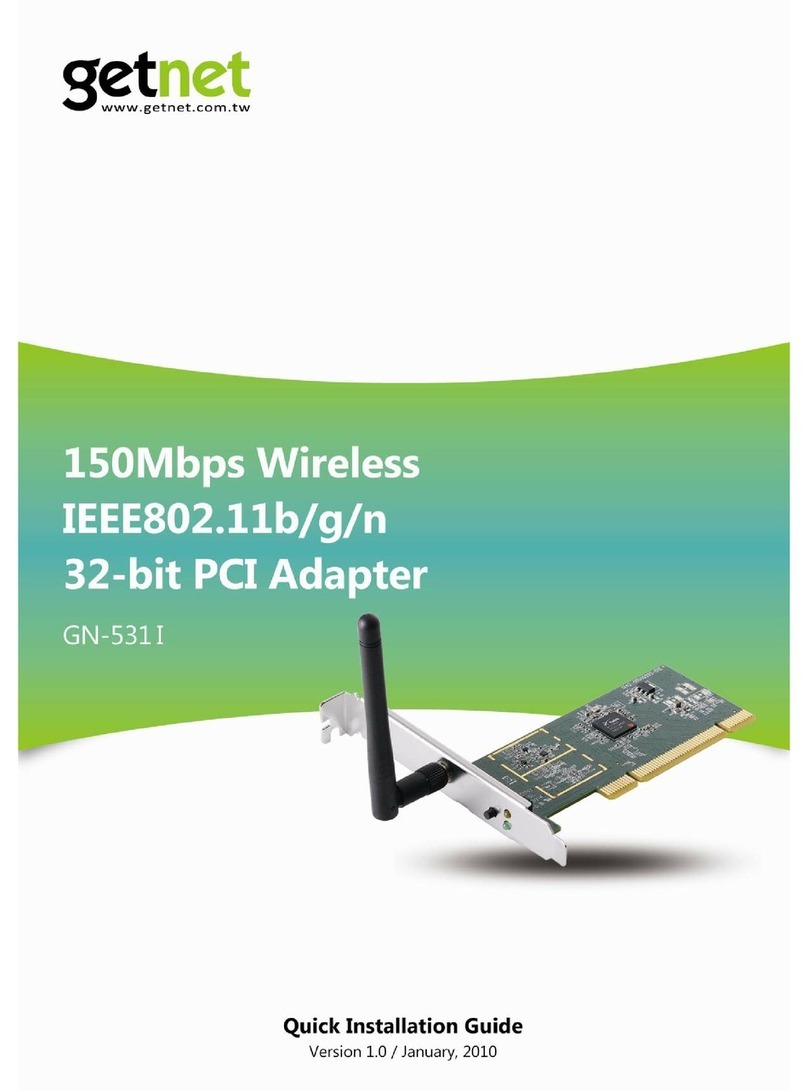Endace DAG 3.6D User manual


EDM01-14 DAG 3.6D Card User Guide
©2005
Version 10: May 2006
Copyright © 2005.
Published by:
Endace Measurement Systems
®
Ltd
Building 7
17 Lambie Drive
PO Box 76802
Manukau City 1702
New Zealand
Phone: ++64 9 262 7260
Fax: ++64 9 262 7261
www.endace.com
International Locations
New Zealand Americas Europe, Middle East & Africa
Endace Technology
®
Ltd
Level 9
85 Alexandra Street
PO Box 19246
Hamilton 2001
New Zealand 2001
Phone: ++64 7 839 0540
Fax: ++64 7 839 0543
www.endace.com
Endace USA
®
Ltd
Suite 220
11495 Sunset Hill Road
Reston
Virginia 20190
United States of America
Phone: ++1 703 382 0155
Fax: ++1 703 382 0155
www.endace.com
Endace Europe
®
Ltd
Sheraton House
Castle Park
Cambridge CB3 OAX
United Kingdom
Phone: ++44 1223 370 176
Fax: ++44 1223 370 040
www.endace.com
All rights reserved. No part of this publication may be reproduced, stored in a retrieval system, or transmitted, in
any form or by any means electronic, mechanical, photocopying, recording, or otherwise, without the prior
written permission of the publisher. Prepared in Hamilton, New Zealand.

EDM01-14 DAG 3.6D Card User Guide
©2005
Version 10: May 2006
Typographical Conventions Used in this Document
•Command-line examples suitable for entering at command prompts are displayed in
mono-space courier font. The font is also used to describe config file data
used as examples within a sentence. An example can be in more than one sentence.
Results generated by example command-lines are also displayed in mono-space
courier font.
•The software version references such as 2.3.x, 2.4.x, 2.5.x are specific to Endace
Measurement Systems and relate to Company software products only.
Protection Against Harmful Interference
When present on product this manual pertains to and indicated by product labelling, the statement "This device complies
with part 15 of the FCC rules" specifies the equipment has been tested and found to comply with the limits for a Class A
digital device, pursuant to Part 15 of the Federal Communications Commission [FCC] Rules.
These limits are designed to provide reasonable protection against harmful interference when the equipment is operated in a
commercial environment.
This equipment generates, uses, and can radiate radio frequency energy and, if not installed and used in accordance with the
instruction manual, may cause harmful interference to radio communications.
Operation of this equipment in a residential area is likely to cause harmful interference in which case the user will be
required to correct the interference at his own expense.
Extra Components and Materials
The product that this manual pertains to may include extra components and materials that are not essential to its basic
operation, but are necessary to ensure compliance to the product standards required by the United States Federal
Communications Commission, and the European EMC Directive. Modification or removal of these components and/or
materials, is liable to cause non compliance to these standards, and in doing so invalidate the user’s right to operate this
equipment in a Class A industrial environment.

EDM01-14 DAG 3.6D Card User Guide
©2005.
i Version 10: May 2006
Table of Contents
1.0 PREFACE........................................................................................................................... 1
1.1 User Manual Purpose......................................................................................................1
1.2 DAG 3.6D Card Product Description .............................................................................2
1.3 DAG 3.6D Card Architecture .........................................................................................2
1.4 DAG 3.6D Card Extended Functions .............................................................................4
1.5 DAG 3.6D Card System Requirements ..........................................................................4
2.0 INSTALLING DAG 3.6D CARD ..................................................................................... 5
2.1 Installation of Operating System and Endace Software..................................................5
2.2 Insert DAG 3.6D Card into PC.......................................................................................5
2.3 DAG 3.6D Card Port Connectors ...................................................................................6
3.0 CONFIDENCE TESTING DAG 3.6D CARD................................................................. 7
3.1 DAG 3.6D Card Sensitivity ............................................................................................7
3.2 Interpreting DAG 3.6D Card LED Status.......................................................................8
3.3 DAG 3.6D Card LED Display Functions .......................................................................9
3.4 Configuration in WYSYCC style..................................................................................10
3.5 DAG 3.6D Card Capture Session..................................................................................10
3.6 Inspect Interface Statistics ............................................................................................12
3.7 Reporting Problems.......................................................................................................15
4.0 RUNNING DATA CAPTURE SOFTWARE................................................................18
4.1 Starting Capture Session ...............................................................................................18
4.2 High Load Performance................................................................................................19
5.0 SYNCHRONIZING CLOCK TIME.............................................................................. 22
5.1 Configuration Tool Usage.............................................................................................23
5.2 Time Synchronization Configurations..........................................................................24
5.2.1 Single Card no Reference Time Synchronization...................................................24
5.2.2 Two Cards no Reference Time Synchronization....................................................25
5.2.3 Card with Reference Time Synchronization...........................................................26
5.3 Synchronization Connector Pin-outs.............................................................................28
6.0 DATA FORMATS OVERVIEW.................................................................................... 30
6.1 Data Formats.................................................................................................................30
6.2 Timestamps ...................................................................................................................32

EDM01-14 DAG 3.6D Card User Guide
©2005.
ii Version 10: May 2006

EDM01-14 DAG 3.6D Card User Guide
©2005
1 Version 10: May 2006
1.0 PREFACE
Introduction
The installation of the Endace DAG 3.6D card on a PC begins with
installing the operating system and the Endace software. This is followed
by fitting the card and connecting the ports.
Viewing this
document
This document, DAG 4.2GE Card User Manual is available on the
installation CD.
In this chapter
This chapter covers the following sections of information.
•User Manual Purpose
•DAG 3.6D Card Product Description
•DAG 3.6D Card Architecture
•DAG 3.6D Card Extended Functions
•DAG 3.6D Card System Requirements
1.1 User Manual Purpose
Description
The purpose of this DAG Card installation guide is to describe:
Installation of Operating System and Endace Software
Confidence Testing DAG 3.6D Card
Running Data Capture Software
Synchronizing Clock Time
Data Formats Overview
Pre-requisite
This document presumes the DAG card is being installed in a PC already
configured with an operating system.
A copy of the Debian Linux 3.1 (Sarge) is available as a bootable ISO
image on one of the CD's shipped with the DAG card.
To install on the Linux/FreeBSD operating system, follow the instructions
in the document EDM04.05-01r1 Linux FreeBSD Installation Manual,
packaged in the CD shipped with the DAG card.
To install on a Windows operating system, follow the instructions in the
document EDM04.05-02r1 Windows Installation Manual, packaged in the
CD shipped with the DAG card

EDM01-14 DAG 3.6D Card User Guide
©2005
2 Version 10: May 2006
1.2 DAG 3.6D Card Product Description
Description
The DAG cards are PCI-bus cards designed for cell and packet capture
and generation, specialised on IP networks.
Various versions have been produced with different interfaces, this
manual describes the DAG 3.6D Dual DS3/T3 co-axial interface.
Figure
Figure 1-1 shows the DAG 3.6D card.
Figure 1-1. DAG 3.6D Card.
1.3 DAG 3.6D Card Architecture
Description
Because of component close association, packets or cells are time-stamped
accurately.
Time stamped packet records are stored in the lower FPGA, which
interfaces to the PCI bus.
All packet records are written to host PC memory during capture
operations.
Continued on next page

EDM01-14 DAG 3.6D Card User Guide
©2005
3 Version 10: May 2006
1.3 DAG 3.6D Card Architecture
, continued
Description
Serial PDH data is received by the DAG 3.6D card co-axial interfaces, and
fed through a Signal Equaliser into the upper of two Xilinx FPGAs.
This FPGA contains a PDH framer and the DUCK timestamp engine. The
close association of these two components means that packets or cells can
be time-stamped very accurately.
Figure
Figure 1-2 shows the DAG 3.6D card major components and process
flow.
Figure 1-2. DAG 3.6D Card Major Components and Process Flow.
Time stamped packet or cell records are stored in a FIFO. The DAG 3.6D
can demap either ADM (ATM Direct Mapped) ATM cells, or PLCP
(Payload Layer Convergence Protocol) ATM cells.
Records are then transferred from the FIFO into the lower FPGA, which
has interfaces to the PCI bus and to the bus of the local StrongARM
processor.
The entire record is made available to the StrongARM processor in a
series of memory-mapped registers.
Code running on the StrongARM is then used to decide if the record
should be written to host PC memory over the PCI bus.

EDM01-14 DAG 3.6D Card User Guide
©2005
4 Version 10: May 2006
1.4 DAG 3.6D Card Extended Functions
Description
The DAG 3.6D card functionality can be extended in many ways.
The functionality of the 3.6D can be extended in many ways. The user can
develop StrongARM code to filter records, or to collect statistics.
The framer is normally set up to map DS3 payloads, but other mappings
are possible.
For detailed information on device address mapping on the StrongARM
bus, or to discuss the use of other extended features contact the Endace
1.5 DAG 3.6D Card System Requirements
Description
The DAG 3.6D card and associated data capture system minimum
operating requirements are:
•PC, at least Pentium II 400 MHz, Intel 440BX, GX or newer chip
set
•Minimum of 128 MB RAM
•At least two free PCI free slot with 3.3V and 5V power
•Software distribution free space of 30MB
•Endace Linux Install CD requires 6GB
Operating
system
For convenience, a Debian 3.1 [Sarge] Linux system is included on the
Endace Software Install CD. Endace currently supports Windows XP,
Windows Server 2000, Windows Server 2003, FreeBSD, RHEL 3.0, and
Debian Linux operating systems.
Different
system
For advice on using a system substantially different from that specified

EDM01-14 DAG 3.6D Card User Guide
©2005
5 Version 10: May 2006
2.0 INSTALLING DAG 3.6D CARD
Introduction
A DAG 3.6D card can be installed in any free Bus Mastering PCI slot
The DAG 3.6D card should be the only device on the PCI bus if possible
as the cards make very heavy use of PCI bus data transfer resources.
Although the driver supports up to four DAG cards by default in one
system, due to bandwidth limitations there should not be more than one
card on a single PCI bus. However, this is not usually a limitation as for
most applications a maximum of two cards only can be used with
reasonable application performance.
In this section
This section covers the following topics of information.
•Installation of Operating System and Endace Software
•Insert DAG 3.6D Card into PC
•DAG 3.6D Card Port Connectors
2.1 Installation of Operating System and Endace Software
Description
If the DAG device driver is not installed, before proceeding with the next
chapter, install the software by following the instructions in EDM04-01
Endace Software Installation Manual.
Go to the next chapter of information when the DAG device driver is
installed.
2.2 Insert DAG 3.6D Card into PC
Description
Inserting the DAG 3.6D card into a PC involves accessing the PCI-X bus
slot, fitting the card, and replacing bus slot cover.
Procedure
Follow these steps to insert the DAG 3.6D card.
Step 1. Access bus Slot
Power computer down.
Remove PCI bus slot cover.
Continued on next page

EDM01-14 DAG 3.6D Card User Guide
©2005
6 Version 10: May 2006
2.2 Insert DAG 3.6D Card into PC
, continued
Procedure (continued)
Step 2. Fit Card
Insert DAG 3.6D card into PCI bus slot.
Ensure free end fits securely into a card-end bracket that supports the card
weight.
Step 3. Replace bus Slot Screw
Secure card with screw.
Step 4. Power Up Computer
2.3 DAG 3.6D Card Port Connectors
Description
There are two metal co-axial BNC connectors on the DAG 3.6D card.
The top co-axial is Port A, furthest from the PCI slot. The bottom one is
Port B.
Port A is receive only, while port B can be ordered as either a second
receive port or a transmit port. Standard configuration is receive.
8-pin RJ45
socket
The DAG 3.6D has an 8-pin RJ45 socket for the time synchronization
input.
CAUTION: Do not connect the socket to an Ethernet.

EDM01-14 DAG 3.6D Card User Guide
©2005
7 Version 10: May 2006
3.0 CONFIDENCE TESTING DAG 3.6D CARD
Introduction
The confidence testing is a process to determine the DAG 3.6D card is
functioning correctly.
The process also involves a card capture session, and demonstrates
configuration in the style of 'What You See You Can Change', WYSYCC.
Interface statistics are also inspected during this process.
In this chapter
This chapter covers the following sections of information.
•DAG 3.6D Card Sensitivity
•Interpreting DAG 3.6D Card LED Status
•DAG 3.6D Card LED Display Functions
•Configuration in WYSYCC style
•DAG 3.6D Card Capture Session
•Reporting Problems
3.1 DAG 3.6D Card Sensitivity
Description
The input signal level to the DAG 3.6D card should be within the dynamic
range of the receiver. If the input signal power is slightly out of range then
an increased bit error rate will be experienced.
If the power is well out of range then the system will be unable to lock to
the PDH frames.
Signal source
specifications
The signal source should meet DS3 template of ANSI-T102.1993 Figure 4
and STS-1 template of ANSIT102.1993 Figure 5, Loss characteristics of
the WE728A or RG 59B cable should be better than Figure C2 of ANSI-
T102.1993.
Receiver
capability
The receiver can handle up to 450 feet of cable loss (5.5dB) from the DSX
cross-connect.
Input signal
level
The input signal level is measured in mVp, the Peak Differential Input
Amplitude in millivolts.
There is an optional high-gain mode that adds 20dB gain. This is intended
for use with DS3 Monitor signal ports. The DS3 Monitor port is a
resistively attenuated (around -21.5dB) copy of the DSX3 cross connect
signal. The minimum signal level at a DSX3 cross-connect is 360mVp, so
the DSX3 Monitor level at minimum is 30mVp, requiring the high-gain
mode.
Continued on next page

EDM01-14 DAG 3.6D Card User Guide
©2005
8 Version 10: May 2006
3.1 DAG 3.6D Card Sensitivity
, continued
Optimum setup
The optimum way to set up a DAG card is to measure the signal level at the
receiver, and to make sure that it is well within the specified range.
Input power can be adjusted, either by changing the splitter ratio if the level
is too high or too low, by inserting an attenuator if the level is too high, or
an amplifier if the level is too low.
Splitters
Passive splitters usually have their insertion losses marked on the package
or in the accompanying documentation.
A 50:50 splitter will have an insertion loss of between 3 dB and 4 dB on
each output. Active splitters may have little or no insertion loss.
3.2 Interpreting DAG 3.6D Card LED Status
Description
The DAG 3.6D card has status eight LED’s, five coloured green and three
red.
Figure
Figure 3-1 shows the DAG 3.6D card status LEDs.
Figure 3-1. DAG 3.6D Card Status LEDs.
Continued on next page

EDM01-14 DAG 3.6D Card User Guide
©2005
9 Version 10: May 2006
3.2 Interpreting DAG 3.6D Card LED Status
, continued
LED definitions
The following table describes the LED definitions.
LED Description
LED 1 Upper FPGA successfully programmed.
LED 2 Lower FPGA successfully programmed.
LED 3 Burst Manager Run. Indicates the card is capturing packets
and transferring them to the host.
LED 4 PPS: Pulse Per Second. Indicates card is receiving an
external clock synchronization signal.
LED 5 SDA. Signal Detect Port A.
LED 6 ERRA. Signal error on Port A, equivalent to Loss of Signal
OR Loss of Framing OR Loss of Cell Delineation.
LED 7 SDB. Signal Detect Port B.
LED 8 ERRB: Signal error on Port B, equivalent to Loss of Signal
OR Loss of Framing OR Loss of Cell Delineation.
3.3 DAG 3.6D Card LED Display Functions
Description
On the DAG 3.6D series of cards LEDs 1 and 2 display when powered up.
When DS3 signals are applied LEDs 6 and 8 should go out, LEDs 5 and 7
should come on. The status of these LEDs should not change during
normal operation of the card.
LED 4 flashes when an external clock synchronization cable is connected
to the RJ45 socket. LED 3 lights when a capture is in progress.
Figure
Figure 3-2 shows the correct LED state for the DAG 3.6D card without
input signal.
Figure 3-2. Correct LED State for DAG 3.6D Card Without Input Signal.
dagthree
utility
The
dagthree
utility supports configuration status and physical layer
interface statistics for the DAG 3.6D card.
When troubleshooting, options
–si
should be passed to the tool to watch
the operational status of the physical, PDH and framing layers. More
details about the meaning of the various bits are supplied through the help
page (
dagthree –h)
as well as via the manual page.

EDM01-14 DAG 3.6D Card User Guide
©2005
10 Version 10: May 2006
3.4 Configuration in WYSYCC style
Description
Configuration in WYSYCC is the 'What You See You Can Change' style.
Running the command '
dagthree'
alone shows the current configuration.
Each of the items displayed can be changed as follows:
Configuration
supported
[no]reset
hold/release framer (in) reset.
[no]fcl
(un)set facility loop back. This is useful for card
chaining.
[no]eql
(un)set equipment loop back. Do not touch.
[no]afix
When set correct single bit ATM HEC errors.
[no]apass
(do not)receive cells with HEC errors. Do not
touch.
[no]aidle
When set pass through received idle cells. Keep set.
[no]ascramble
Dis/enable descrambling of ATM cells. Keep set.
[no]adm
(do not)use ATM Cell Direct Mapping, otherwise
PLCP Mapping.
[no]m23
(do not)use m23 framing, otherwise c-bit framing.
[no]highgain
(do not)add 20dB extra gain to Rx.
3.5 DAG 3.6D Card Capture Session
Description
The DAG 3.6D card uses the SONET PDH ATM physical layer interface
device to support capturing of ATM. The card supports the DS3 standard.
A successful DAG card capture session is accomplished by checking the
receiver ports optical signal levels and checking the card has correctly
detected the link. This is followed by configuring the DAG card for
normal use.
Procedure
Follow these steps to troubleshoot DAG card configuration.
Step 1. Check Receiver Ports Signal Levels.
Ensure that the signal levels reaching the receiver ports of the card are at the
right levels.
Step 2. Understand Link Layer Configuration
Learn about the link layer configuration in use at the network link being
monitored. Important parameters include m23 Vs. c-bit framing, as well as
the specific scrambling options in use.
If the information cannot be obtained reliably, the card can be made to work
by varying the parameters until data is arriving at the host system.
Continued on next page

EDM01-14 DAG 3.6D Card User Guide
©2005
11 Version 10: May 2006
3.5 DAG 3.6D Card Capture Session
, continued
Procedure
, continued
Step 3. Check Card is Locked to Data Stream
Configure card according to local settings.
Check through the physical layer statistics that the card is locked to the data
stream.
Step 4. List Current Settings
For DAG 3.6D framer configuration and statistics the
dagthree
tool is
supplied.
Calling
dagthree
without arguments lists current settings.
The dagthree -h
prints a help listing on tool usage.
Step 5. Check FPGA Image Loaded.
Before configuring the card, ensure the most recent FPGA image is loaded
on the card.
dag@endace:~$ dagld -d dag0 -x dag/xilinx/dag36pci-
erf.bit:dag/xilinx/dag36atm-erf.bit
If the FPGA image load fails with the message similar to:
dagld: panic: Cannot replace a d360pci-timed.ncd with a
dag36dpci_atm-erf_pci_v2_2 function image
Add the
–f
flag to
dagld
.
Continued on next page

EDM01-14 DAG 3.6D Card User Guide
©2005
12 Version 10: May 2006
3.5 DAG 3.6D Card Capture Session
, continued
Procedure
, continued
Step 6. Configure in WYSYCC Style
dag@endace:~$ dagthree -d dag0
linkA noreset noadm nom23 nohighgain nofcl noeql
atmA noapass ascramble noaidle afix
linkB noreset noadm nom23 nohighgain nofcl noeql
atmB noapass ascramble noaidle afix
packetA drop=0
packetB drop=0
pci 33MHz 32-bit buf=32MB rxstreams=1 txstreams=0 mem=32:0
If the card is configured for c-bit (nom23) framing mode but m23 framing is
required, removing or adding the "no" prefix will change the setting. Type:
dag@endace:~$ dagthree -d dag0 m23
linkA noreset noadm m23 nohighgain nofcl noeql
atmA noapass ascramble noaidle afix
linkB noreset noadm m23 nohighgain nofcl noeql
atmB noapass ascramble noaidle afix
packetA drop=0
packetB drop=0
pci 33MHz 32-bit buf=32MB rxstreams=1 txstreams=0 mem=32:0
3.6 Inspect Interface Statistics
Inspect
interface
statistics
Once the DAG 3.6D card has been configured as expected, the interface
statistics should be inspected to see if the card is locked to the data stream.
dag@endace:~$ dagthree -d dag0 -si

EDM01-14 DAG 3.6D Card User Guide
©2005
13 Version 10: May 2006
Status bits
display
The tool will display a number of status bits as they have occurred since
the last time read. In our example, the interval is set to one second via the
-i
option.
LoS
DS3 Loss of Signal.
This indicates that there is no signal at the receiver
or signal strength is too low to be recognized.
LoF
DS3 Loss of Framing.
DS3 OoF has been asserted for more than 3 ms.
OoF
DS3 Out of Framing.
The DS3 Framer is not synchronized.
LoF
PLCP Loss of Frame
PLCP OoF had been asserted for more than 3 ms.
OoE
PLCP Out of Framing
The PLCP Framer is not synchronized
LCD
Loss of cell delineation for 22 or more cells
The ATM state machine has no lock onto the ATM
cell stream.
HEC
There is an ATM Header Error Code failure.
Sig
Line Interface Unit Signal Detect There is a valid
input signal present.
Syn
ATM cell sync.
The ATM cell engine has locked to the ATM cell
stream.
Idle
An ATM Idle cell is being received.
Cell
A non-idle ATM cell is being received.
Continued on next page

EDM01-14 DAG 3.6D Card User Guide
©2005
14 Version 10: May 2006
3.6 Inspect Interface Statistics
, continued
Card locked to
DS3 ATM
stream example
An example of a card locked to a DS3 ATM stream is:
A: LoS LoF OoF LoF OoF LCD HEC Fix Sig Syn Idle Cell
0
0
0
0
0
0
0
0
1
1
0
0
0
0
0
0
0
0
0
0
1
1
0
0
0
0
0
0
0
0
0
0
1
1
0
0
No valid signal
example
An example of when there is no valid signal input is:
A: LoS LoF OoF LoF OoF LCD HEC Fix Sig Syn Idle Cell
1
1
1
1
1
1
0
0
0
0
0
0
1
1
1
1
1
1
0
0
0
0
0
0
1
1
1
1
1
1
0
0
0
0
0
0
Status bits
The PLCP LoF and OoF status bits are not valid during ADM operation,
and will read as 0.
General
purpose
counters
Programmable counters are not available on the DAG 3.6D with this
release.
Test trace
If those tests provide a satisfactory status, a test trace should be taken. We
suggest a 10 seconds trace file by passing the option
-s 10
to
dagsnap
,
along with option
-v
for more user information.

EDM01-14 DAG 3.6D Card User Guide
©2005
15 Version 10: May 2006
3.7 Reporting Problems
Description
If there are unresolved problems with a DAG card or supplied software,
contact Endace Technical Support via the email address
Supplying sufficient information in an email enables effective response.
Problem
checklist
The exact information available to users for trouble, cause and correction
analysis may be limited by nature of the problem. The following items
assist a quick problem resolution:
Ref Item
1. DAG card[s] model and serial number.
2. Host PC type and configuration.
3. Host PC operating system version.
4. DAG software version package in use.
5. Any compiler errors or warnings when building DAG driver or
tools.
6. For Linux and FreeBSD, messages generated when DAG device
driver is loaded. These can be collected from command
dmesg
,
or from log file
/var/log/syslog.
7. Output of
daginf
.
8. Firmware versions from
dagbug –cx
.
9. Physical layer status reported by:
dagthree
10. Network link statistics reported by:
dagthree –si
11. Network link configuration from the router where available.
12. Contents of any scripts in use.
13. Complete output of session where error occurred including any
error messages from DAG tools. The
typescript
Unix utility
may be useful for recording this information.
14,. A small section of captured packet trace illustrating the problem.
Table of contents
Other Endace PCI Card manuals
Popular PCI Card manuals by other brands
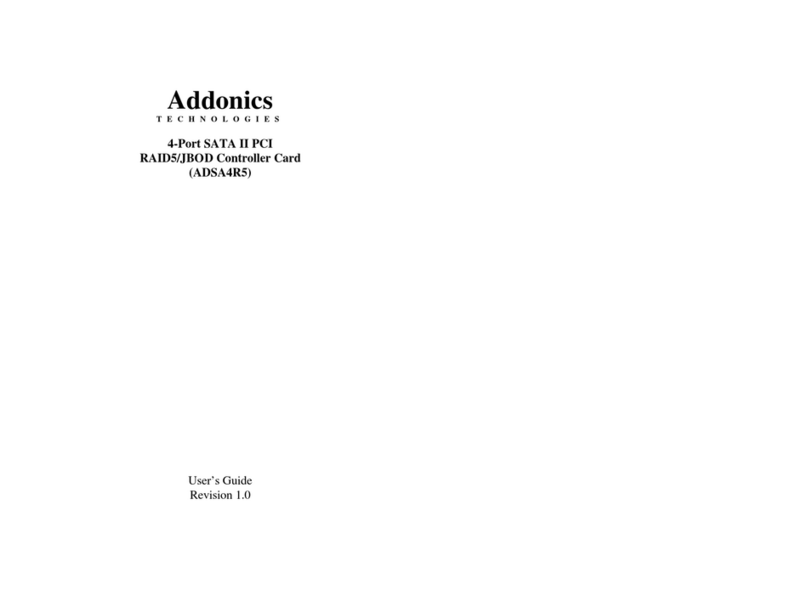
Addonics Technologies
Addonics Technologies ADSA4R5 user guide
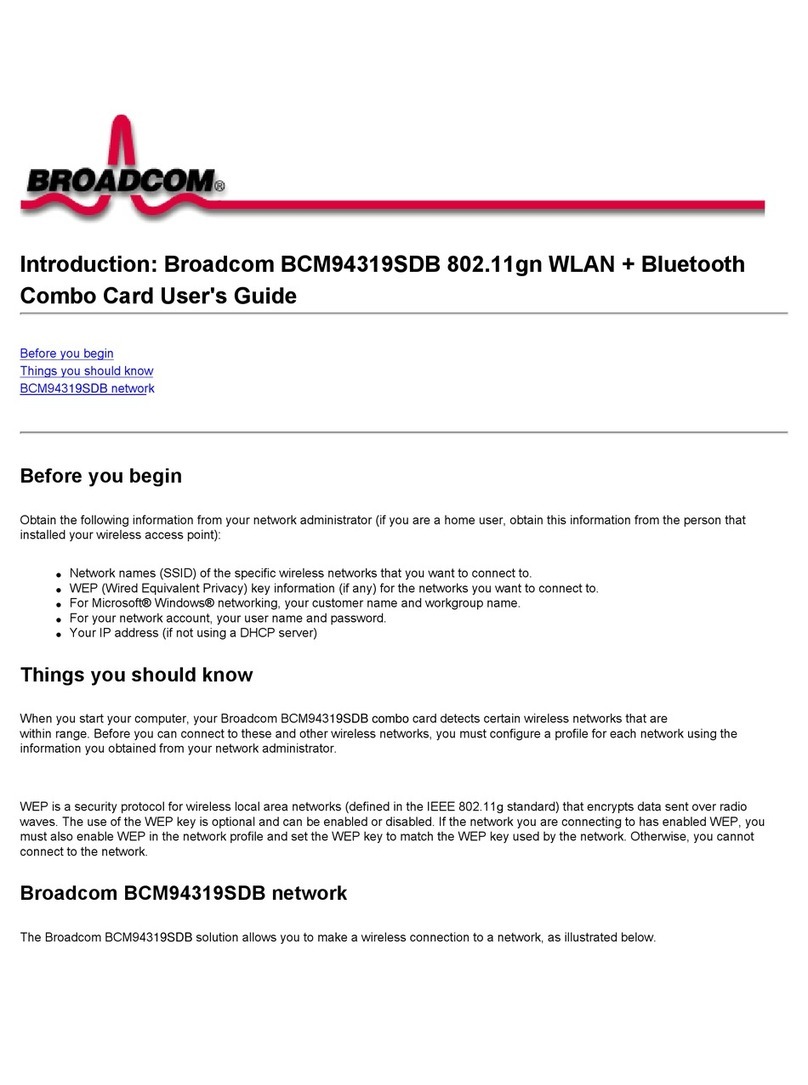
Broadcom
Broadcom BCM94319SDB user guide
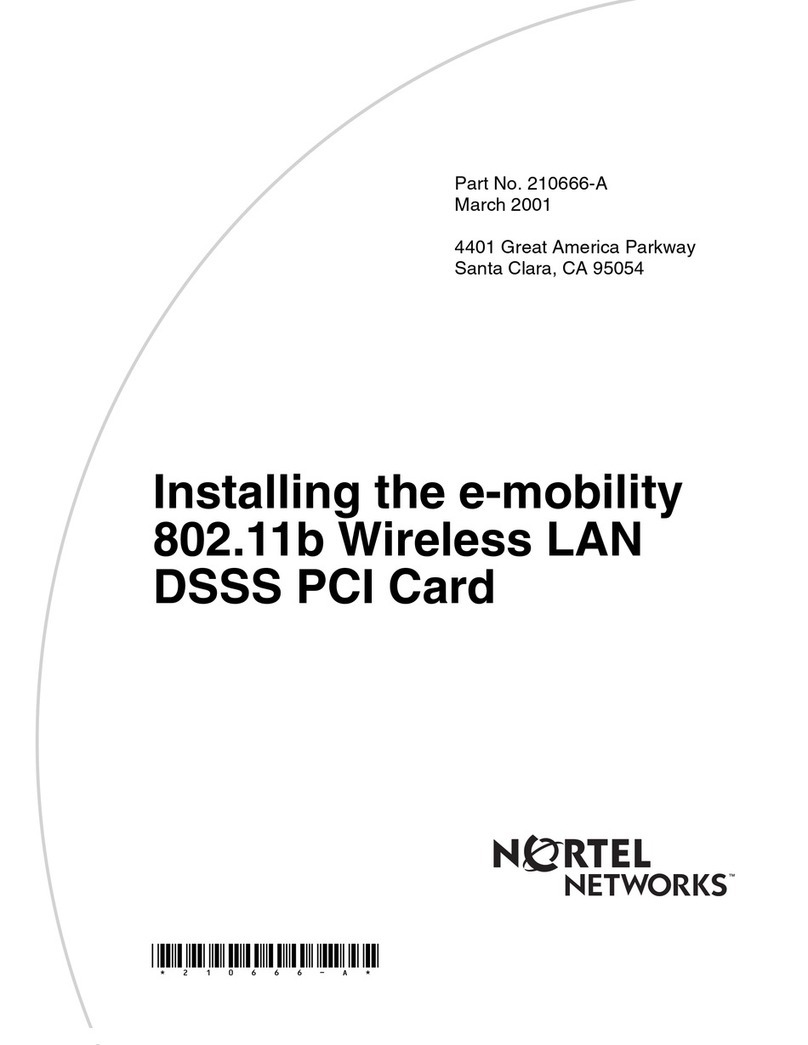
Nortel
Nortel e-mobility 802.11b Wireless LAN DSSS PCI... Installation
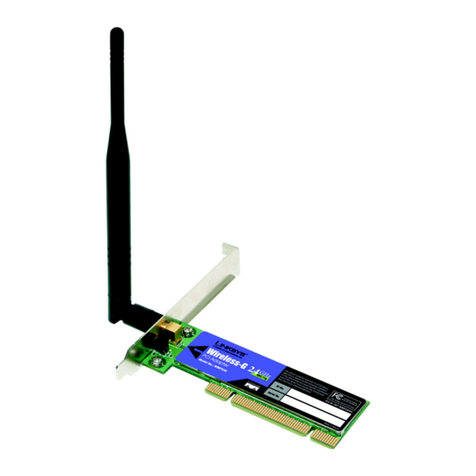
Cisco
Cisco WMP54G user guide
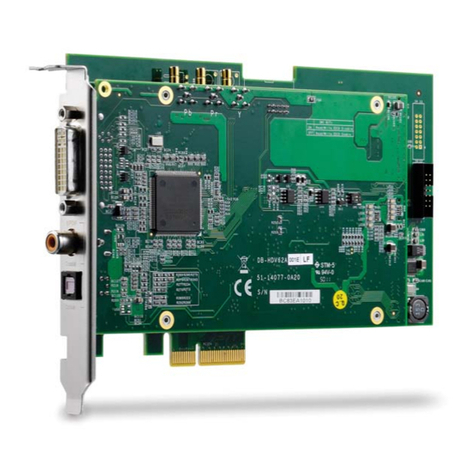
ADLINK Technology
ADLINK Technology HDV62A Library reference
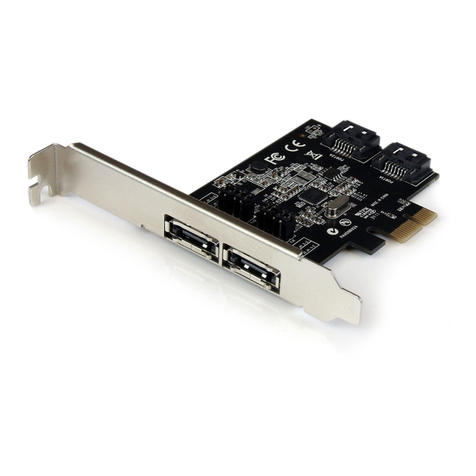
StarTech.com
StarTech.com PEXESAT322I instruction manual

